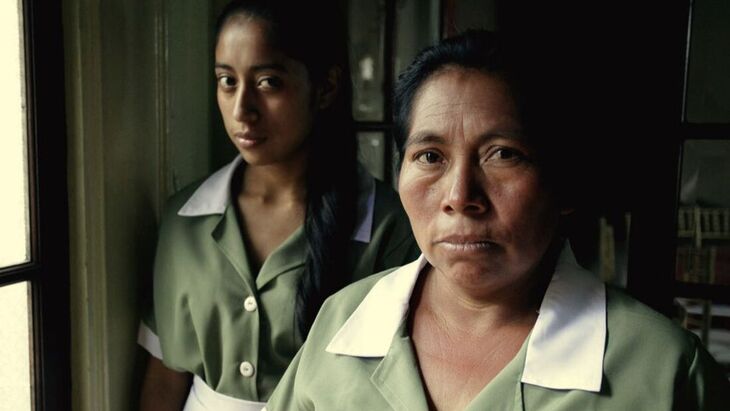 Legends, folklore, cryptids and curses all light up the right bulbs in my brain... ...Most nights you’ll find me drifting off to sleep to the soothing voices of spooky story narrations. Not the most exciting way to spend an evening, but it’s the kind of stuff I live for, which is why I was thrilled to watch Jayro Bustamante’s La Llorona. Earning high marks at the 2020 Sundance Film Festival, the film has gained good traction with cinephiles. Not to be confused with 2019’s underwhelming The Curse of La Llorona, this retelling of Latin America’s most feared bedtime story is an unconventional renaissance for the famed tale. With an emphasis on family drama and political commentary, this is the last territory you would expect any incarnation of the story to visit. Such bold departures have a tendency to sometimes backfire, but if handled with proper care and given the right talent, anything can be transformed with the essence of its source in tow. Guatemalan dictator Enrique (Julio Diaz) has found himself in a bit of a jam. After long and drawn out military occupation, Enrique and his subordinates have been accused and put on trial for the rape and murder of several locals. Outrage and unrest over the trial have flooded the streets and, unfortunately for Enrique and his family, the protests have spilled into the surroundings of their estate. Advised to remain confined to their house under the protection of armed guards, the family face anarchy outside and constant tension, misfortune, and distrust within their own walls. To make matters worse, several of the superstitious housekeepers abandoned their comfortable job arrangement after hearing what sounded like a weeping woman in the dead of night. Short on staff and desperate, Enrique’s wife, Carmen (Margarita Kenéfic), hastily hires a new house maid named Alma (Maria Mercedes Coroy). Soon after Alma’s arrival, strange occurrences and unexplained physical ailments slowly plague the family. Over many years, Enrique’s daughter, Natalia (Sabrina De La Hoz), has appointed herself peacekeeper of the family and struggles to harness the weight of the toxic household. Family drama and age-old quarrels can be taxing and soul crushing for us all. However, as an outsider looking in, the dissection of such insufferable experiences can be infinitely interesting and at times, scary as Hell. La Llorona invites us to be a fly on the wall and observe the unraveling of an already broken family. As sad and upsetting as the subject may be, the level of engagement and involvement that this film offers is incredibly rich and fulfilling. Any reservations I had about the film straying from its source material vanished once I was hooked on understanding the many secrets and deep wounds of this family. And, to my surprise, the original tale of La Llorona is both organically woven into the narrative and given the space to come full circle. This is a cold film; it does not entice you to sympathize with its characters. I don’t often see this kind of emotional distance in film, and while some may feel it as more repellant, I respect the fact that I wasn’t being manipulated to like or dislike anyone in particular. La Llorona proves you don’t need to coerce emotional connection from viewers, only fascinating characters. Every actor in this film commits to their roles very honestly and it was evident that they took this material very seriously. Margarita Kenéfic is exceptional, as her character struggles to uphold her obligatory wifely duties while denying and ignoring a torrent of emotional pain. Sabrina De La Hoz also gives a standout performance. She becomes the punching bag for most of her family’s hardships, as they look to her to mend their issues and speak on their behalf. In a film that does not ask for connection, I found myself deeply sympathizing with her situation. Maria Mercedes Coroy is unquestionably committed to the role of Alma and her longing, melancholic gaze is hypnotically creepy. Technically, La Llorona showcases great reverence for the sheer craft of filmmaking. The framing in every scene is deliberate and impressively executed. Many of the scenes start and end with a slow, zooming pan, adding to the eeriness of the atmospheric dread. There are no quick cuts, even in moments of frenzy and motion. I got the impression that it implies a hidden watchful eye. There’s no way of knowing if that was the intention, but it’s clearly a stylistic choice to evoke unease, like an uncomfortable silence. There are several dream sequences that do an exceptional job of giving us bits of exposition. The use of sepia hues in these scenes work in direct contrast with the film’s largely populated greys and harsh whites. The dream scenes are also spread out in a way that keeps the pacing of the film evenly balanced. The only notable criticism I have with the film is the handling of its political themes. The entire film is not relegated to a political message by any means, but the inclusion of comments on communism and class structures sometimes took away from the excellently established foreboding atmosphere. While it felt a little heavy-handed for me at times, I expect many will find this commentary a welcome aspect of this haunting story. La Llorona is a breath of fresh air for fans of folklore. A deeply involved family drama with a clever point of entry for its legend, its hypnotic story and characters make it easy to forgive any criticism of its social commentary. La Llorona is an unmissable tale of a haunting cultural mythology and family tension debuting on Shudder August 6th. By Jeffrey W. Hollingsworth
0 Comments
Leave a Reply. |
Archives
March 2023
|


 RSS Feed
RSS Feed